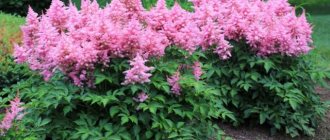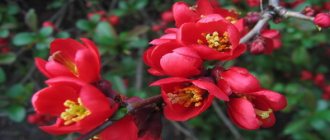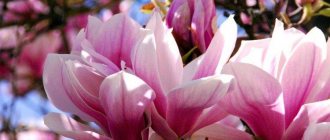The leading place in terms of decorativeness, without a doubt, is occupied by sakura or Japanese cherry.
If garden cherries are valued for their fragrant fruits, then sakura has gained its popularity as the most beautiful ornamental plant for landscape design.
Japan and China are considered the birthplace of this ornamental plant. Varieties and hybrids were bred there, which now determine the decorativeness and beauty of Japanese cherries.
Popular types of oriental cherries
Kiku Shidare lat. Kiku Shidare Sakura
| |
Short-shielded cherry
| |
Sakhalin sakura
| |
Cherry finely serrated Kanzan lat. Prunus serrulata Kanzan
| |
Ferruginous cherry lat. Cerasus glandulosa
| |
Royal Burgundy lat. Royal Burgundy
|
Propagate by seeds and cuttings
Growing from seeds
| |
Growing by cuttings
|
Comments (2)
Olga
01/05/2020 at 13:17 |
Why is there no mention of growing sakura from seeds?Answer
Yulia Expert Plodogorod
01/09/2020 at 20:18 |
Hello Olga! Propagation of such cherries using seeds is not very common due to poor germination - 15-20%. In addition, this is a long and complex process; several years will pass before the first flowers appear.
If you decide to grow sakura this way, it is worth purchasing planting material from several manufacturers, this will increase the chances of getting a sprout. Planting material will require stratification for 3 months. To do this, the seeds must be placed in damp sand and kept at a temperature of about 4 degrees for the specified period.
After, immediately before planting, the seeds need to be soaked for 24 hours. This requires warm moisture. Afterwards, you can lightly scratch the planting material with fine sandpaper so that germination occurs faster.
Planting is carried out in a wide, shallow container filled with disinfected sand or vermiculite. Planting depth is 1 cm. After planting, it is better to water the future sakura with a fungicide solution. It is better to cover the container with film. For germination, a temperature of 7-10 degrees is required.
After 10-15 days, sprouts will appear. The temperature should be raised to 15-20 degrees, and plenty of lighting and watering should be provided. When they get stronger, pick them up into separate containers.
Answer
Plant to the east
Where to plant
| |
When to plant
| |
How to plant
| |
How to care
|
The video shows what Japanese sakura looks like, plus an experienced agricultural technician tells how to plant and care for such trees. Special mention is made of preparation for winter and types of fertilizers.
Features of varieties for regions
In central Russia in winter, severe frosts (below -30 degrees) are rare and short-lived. There is enough snow and it lasts until March. In spring, recurrent frosts are an annual phenomenon. Cold snaps occur almost every spring until mid-April, so when choosing cherry varieties, you should take into account the time of their flowering. In summer, the temperature is stable; intense heat can last for several days. There is a lot of rainfall in autumn. This climate is favorable for plants. Frequent rains in summer, in warm weather, can cause the spread of fungal diseases. In this region, varieties with average winter hardiness, resistance to infections and with different ripening periods will grow well. Such as Amorel, Meteor, Memory of Vavilov, Vyanok, Izobilnaya, Vostorg, Leningradskaya black and many others.
In the Moscow region , the seasons are separated, their change takes place smoothly over 2.5–3 months. In spring, return frosts are frequent, which can affect early flowering plants. Summer is warm, the average temperature is 22–25 degrees, intense heat occurs and can last for several days. In some years, there is heat of more than 30 degrees, which lasts for several weeks, but this has not become a constant phenomenon. Stable temperatures in summer, with frequent precipitation, are suitable conditions for the development and spread of fungal infections. Snow usually stays all winter. Frosts, on average, remain at 10–12 degrees. There are thaws and severe colds, but not for long. In autumn, frosts begin in mid-October, and by the end of November snow cover may be established. In the Moscow region, cherry varieties with average winter hardiness and disease resistance will grow and bear fruit well. There are no restrictions on the ripening period; berries of late types have time to ripen until autumn. Prichuda, Assol, Studencheskaya, Brusnitsina, Tamaris, Griot Moskovsky and others will be most suitable for growing in the Moscow region.
Kuban is one of the few regions in the country where climatic conditions allow cherries to be grown without regard to winter hardiness, flowering time and ripening time. The southern regions are located in the subtropical zone, where citrus fruits grow and bear fruit well. Winter is characterized by unstable weather, with frequent thaws and frosts. The thermometer rarely drops -5–8 degrees, so the soil rarely freezes. Snow melts very quickly and rarely remains for several days. The warm period of the year is 9–10 months. Warmth sets in very quickly; air temperatures of +20+22 degrees in early May are common. The duration of summer here is 4–5 months. There is enough precipitation, but in the steppe regions dry periods occur frequently. In Kuban you can grow varieties with any winter hardiness and different ripening periods. A lot of varieties of cherries are grown here, which in more northern regions do not produce such quality berries due to lack of heat. Varieties such as Kelleris, Novodvorskaya, Black Morel, Victoria, Anthracite and others will grow well here.
Bashkiria is characterized by a clear division of seasons. Summer is hot and dry. Winter is frosty, with rare thaws. Snow remains for up to three months. Spring and autumn pass very quickly, in just 1–1.5 months. Plants have a difficult time with a sharp transition from cold to heat. There is very little precipitation in the summer, but droughts and hot winds from Kazakhstan are a common phenomenon in Bashkiria. To successfully grow cherries, it is better to choose varieties with resistance to frost and drought. Tall trees (over 4 m) will suffer from strong winds, so low-growing and bushy forms will be the best option. For Bashkiria, we can recommend varieties such as Anthracite, Fairy, Oktava, Bolotovskaya, Rusinka, Biryusinka and many others.
in Belarus is mild. In winter, the average temperature is -8–10 degrees, and in summer it stays at around +20 degrees. There are fluctuations in one direction or the other, but they don’t last long. There is a lot of precipitation throughout the year. Fogs are frequent, which can lead to the development and spread of fungal infections in gardens. Strong winds are not typical for the local climate. Selection work is being carried out in the Republic, including with cherries. There are many excellent Belarusian varieties that are in demand not only locally, but also in Russia and other countries. Meteor, Kelleris, Khutoryanka, Lada, Rusinka, Ksenia and others can also be recommended for growing here
Recent Entries
Lilac perennials that are beautiful, compact and do not crowd out other plants Why when buying seedlings you should not take the sellers’ word for it and how to determine the age of the plant using 3 signs Tomato seedlings have turned purple or whitish: why the color has changed and how to save the plants
Siberia and the Urals have the most severe climatic conditions for gardening. Frosty winters and hot summers, cold springs and early onset of cold weather dictate certain requirements for fruit trees, including cherries. In these regions, low-growing and shrubby varieties with high winter hardiness and early and medium ripening will grow and bear fruit better. Although in the southern regions of Siberia and the Urals, cherries manage to ripen in August. At the same time, in the northern regions of the region, early species during flowering may be affected by spring frosts. It is preferable to choose local, regionalized varieties, the choice of which is quite large, or choose low-growing or bush forms with high frost resistance. This could be Sverdlovchanka, Biryusinka, Vyanok, Zaranka, Prichuda, Izobilnaya, Ashinskaya and many others.
In the Northwestern region, winters are long and cold, with high snow cover. Summer is short and cool, and the proximity of the sea gives a lot of rainfall and high humidity. In spring, frosts are not uncommon even in May. Late ripening varieties do not always have time to ripen, so early and middle varieties with good frost resistance and resistance to infections are preferable. Branches of tall (over 4 m) trees may freeze or break due to large amounts of snow. Low-growing and bushy varieties will winter better. The most suitable for this region will be Ashinskaya, Apukhtinskaya, Bolotovskaya, Izobilnaya, Shubinka, Zhelannaya, Leningradskaya Chernaya and others.
In Ukraine, a cherry tree is sure to grow in every home. The gardens occupy large areas. Who doesn’t know the famous Ukrainian dumplings with cherries? This is a national dish, like dumplings among Siberians. The climate in Ukraine is mild, which is greatly facilitated by the proximity of two seas. In the steppe regions, heat and drought are not uncommon in summer. Winters are not very severe, on average -8–12 degrees. There is a lot of snow in the northern and mountainous regions. The change of seasons occurs smoothly, within 1.5–2 months. In the south, the warm period is longer, up to 7–8 months a year. Precipitation is frequent, but in the steppe regions it is insufficient. To grow cherries, it is better to give preference to local varieties, of which there are a large number. Plants with any ripening period are suitable for planting. You can choose the height of the tree based on your preferences. Belarusian varieties also grow well here. High frost resistance is not of great importance here, but attention should be paid to drought resistance. Victoria, Nord Star, Alpha, Ksenia, Black Morel, Rossoshanskaya black, Memory of Vavilov and others will delight you with a good harvest.
In the Black Earth Region, winters are not particularly cold, with an average of about -10 degrees. Severe frosts occur, but do not last long. In summer the temperature is around +22 degrees. There is enough precipitation. Spring frosts are typical, which in some years occur in June. In autumn, the thermometer may drop into the negative range as early as the end of September. All this dictates certain requirements for the selection of cherry varieties. The plant must have average frost resistance and resistance to infections. It would be good if it was a self-fertile variety. In some years, late-ripening plants may not have time to ripen, and the earliest ones are at risk of damage by spring frosts. Amorel, Meteor, Memory of Vavilov, Khutoryanka, Lada, Radonezh, Tamaris, Octave and many others will grow well in this region.
Diseases and pests
| Cherry coccomycosis Symptoms:
Treatment:
| |
| Cherry moniliosis Symptoms:
Treatment:
| |
| Cherry slimy sawfly Symptoms: In June-July, small dark slugs appear on the underside of the leaves and feed on tree sap. In a short time the leaf dries completely. Treatment: Slugs are destroyed with Piliton or Actellik |
Options for using berries
The fruits of Chinese cherries are tender, distinguished by their juiciness and taste, harmoniously combining sweetness and acidity. Thanks to this, the berries are suitable for making juices, syrups, and fruit drinks. In home brewing, wine, tincture and liqueur based on these cherries are popular.
Housewives often use the harvest to make jam, jam, and compote for the winter. Cooks make marmalade from berries.
Advice! When canning vegetables, you can add cherry leaves to marinades and pickles.
Felt Chinese cherry looks beautiful throughout the season. In May it is densely covered with luxurious flowers. And by the end of June, garlands of burgundy or red berries are visible on the branches. This plant is popular among amateur gardeners.
Reviews from gardeners
Iren1
Sakura is a “made” variety of cherry with a DECORATIVE purpose... not for the sake of fruits, but for beauty... But there are, of course, cherries with fruits...
Source: forum-beta.sakh.com
Ruslan... Just Ruslan
in the city of Alexandria, Kirovograd region. three or four cherry blossoms have been growing in the central square for 5-7 years, very large trees; when it was in season, I saw them blooming - a very beautiful sight
Source: forum.gorod.dp.ua
What to remember
- Features of Japanese cherry . Varieties of this tree are distinguished not by fruits or crown, but by color, size and number of petals in the inflorescence. For landscaping in a small garden, shrub varieties, for example, Chinese sakura, are more suitable.
- Purchasing a seedling . At home, sakura can be grown from a seed or cuttings. A purchased seedling must be at least 70 cm tall.
- Planting and care . Sakura loves sunny meadows in a quiet, windless place. The planting technology is the same as for all fruit trees. For abundant flowering, you need to abandon nitrogen fertilizers in the second half of summer and focus on potash fertilizers.
Growing sakura
Growing conditions
The main condition for normal tree growth is the composition of the soil and the absence of through penetrating winds.
It is the piercing wind that becomes the most important negative factor for the normal growth and flowering of decorative cherries.
All varieties of sakura require plenty of sunlight and loose soil.











